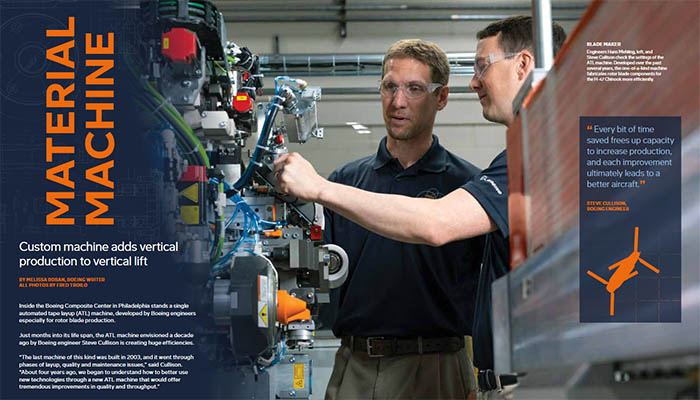Inside the Boeing Composite Center in Philadelphia stands a single automated tape layup (ATL) machine, developed by Boeing engineers especially for rotor blade production.
Just months into its life span, the ATL machine envisioned a decade ago by Boeing engineer Steve Cullison is creating huge efficiencies. “The last machine of this kind was built in 2003, and it went through phases of layup, quality and maintenance issues,” said Cullison. “About four years ago, we began to understand how to better use new technologies through a new ATL machine that would offer tremendous improvements in quality and throughput.”
Plying it on
Boeing teammates use the ATL machine to fabricate uniform rotor blades for the H-47 Chinook. The heavy- lift helicopter, operated by the U.S. Army and defense forces of 20 other nations, is known for its ability to adapt to rugged terrain. The H-47 Chinook can fly up to 20,000 feet (6.1 kilometers) and haul over 27,000 pounds (12.2 metric tons). To do that, the helicopter relies on its powerful rotor blades.
To create the internal structural components of a rotor blade, the ATL machine layers ply packs, or plies, on top of one another, then slits each stack-up to create multiple parts. Operators used to trim each ply layer by hand to ensure standard conformance.
Cullison proposed a concept for a rotating head for the machine that allows bidirectional tape layup, layering the plies both horizontally and vertically. Switching to vertical tape layup offers three benefits — greater layup and trimming accuracy, improved material quality and less weight variability in final assembly.
Saving four production hours per blade and cutting almost three hours of manual labor per blade, teammates can devote more time to collecting production data and improving production quality. They are also scrapping fewer parts and reducing waste along the way.
Automation advancements
The composite manufacturing industry at large was a source of ideas for Cullison as he developed requirements for the new ATL machine.
“Insights from an enterprisewide automation project, site visits and technical conferences helped me understand how to implement newer technologies into our production system,” Cullison said.
For example, he discovered that configuring horizontal vacuum tables vertically helped to better manage film releases and parts handling. Suction constrains the release film and supports the laid up parts, easing the manufacturing process.
Bumpy to smooth
Cullison and his teammates navigated many challenges on the road to smooth production, and their persistence paid off.
“You can’t buy this type of machine off the shelf, and you don’t know what you’re dealing with until you cross the bridge,” said engineering manager Peggy Castaneda.
In hours of trial and error, the team stayed motivated, pushing through doubts to find new solutions in additive manufacturing or through spool tension optimization. When the challenges piled on, the solutions flowed, and now the final result is in use on the floor. “Anytime we innovate our processes, the technical challenges come with it, so it’s not a smooth journey,” Castaneda said. “Talented engineers find a way to make things work. They overcame many challenges and worked together to implement this equipment. To make it work is huge.”
What’s next?
After using the new ATL machine for about a year, Cullison and his teammates are collecting data to assess the machine’s reliability and sustainability. As they continue evaluating their fabrication processes, they are considering other uses for the machine and looking to further enhance its efficiency. For example, they are studying ways to reduce the number of material spool changes.
“Every bit of time saved frees up capacity to increase production, and each improvement ultimately leads to a better aircraft,” Cullison said. “We’re always looking into technologies to improve processes, increase efficiency, and improve the safety and quality of our products.” IQ






Be the first to comment on "Custom machine adds vertical production to vertical lift"